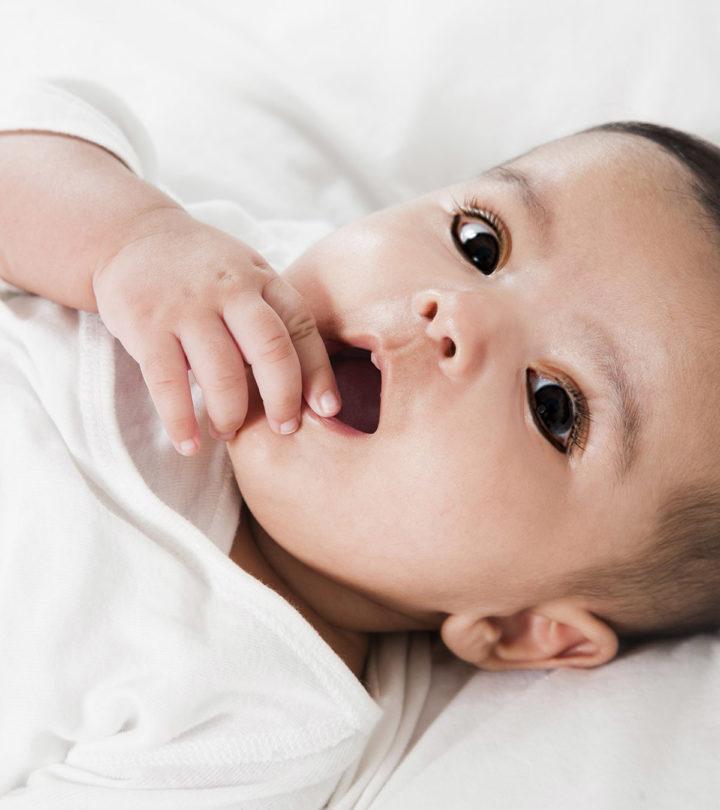Which Kajal Is Best for Newborn Baby

Image : Shutterstock
Kajal, also known as surma or kohl, is commonly used as an eye care product since ancient times in India, Pakistan, the Middle East, and some parts of Africa (1). The product is an eye preparation in the ultra-fine form of specially processed kohl stone (galena) incorporated with some other therapeutically active ingredients (2). Alternatively, people also prepare kajal at home using edible oils.
There are several cosmetic uses of kajal. But is it safe to be used for babies? In this Momjunction post, we tell you about the safety of kajal for babies, its side effects, and probable alternatives you could consider. We also tell you the process of making kajal at home.
Is Kajal Safe For Babies?
Kajal has been in use in several cultures. Although there is no research-based evidence available, people usually make kajal at home or buy the ones manufactured using natural ingredients.
However, in the past few years, research has said that kajal is not safe for babies. Most medical experts and healthcare organizations recommend against the use of kajal for babies (2) (3).
- According to the U.S. Food and Drug Administration (FDA), store-bought or commercial kajal is not safe for babies since it contains lead. The lead comes from the galena stone (kohl stone), which naturally contains the element. The FDA considers kajal as an illegal color additive in the US.
- Some researchers found that store-bought kajal has high levels of lead and other chemicals like galena, minium, amorphous carbon, magnetite, and zincite. These chemicals might harm the baby's eyes.
Why Do People Use Kajal For Their Babies' Eyes?
Kajal has been in use for generations in various Asian cultures.
- People believe that applying kajal to the baby's eye keeps the evil eye away. There may not be any logical explanation for this belief. If you want to apply kajal for ceremonial reasons, then you may apply a dot on the forehead, cheek, under the feet, or some other part of the body.
- There is a belief that applying kajal to the baby's eye will make their eyes brighter, bigger, and longer. But there is no research-based evidence to prove this.
- It is believed that kajal will have a soothing effect on the baby's eye. However, it might cause irritation, and this is one of the reasons why pediatricians advise against the use of kajal (4).
- Some people say that kajal helps the baby sleep better, but there is no scientific evidence on it.
- There is also a belief that kajal helps in avoiding diseases like blepharitis and conjunctivitis , whereas it may actually result in these diseases.
What Are The Reasons To Avoid Kajal?
The main reason to avoid kajal is its lead content, which can cause health issues. Below is the list of problems caused by lead and other reasons to avoid kajal (2) (3).
- According to the FDA, the use of commercial kajal could cause lead poisoning, which can increase the risk of developing anemia and kidney problems. Lead poisoning might also cause neurological damage that may lead to seizures and coma.
- The prolonged application of kajal might increase lead levels in the body, thus causing adverse effects on the brain and bone marrow.
- Kajal is often applied with the fingertip. Observing poor hygiene while making the application could expose the baby's eyes to pathogens.
The side-effects mentioned above are mostly relevant to the readymade kajal available in the stores. However, a study found that homemade kajal too could contain some amount of lead (1). Also, even if you are making kajal at home, dirty fingers or rough edges of your nails can harm the baby's eyes. Moreover, you may not be able to prepare kajal under strict hygienic conditions at home.
How Is Kajal Made At Home?
Here is how kajal is made at home.
- Take two flat-bottom metal bowls and invert them.
- Put a flat metal plate, inverted, on the top of the bowls in a way that the plate would form a bridge.
- Place an earthen lamp filled with pure ghee or pure organic castor oil or almond oil under the bridge. Put a wick in it and light it.
- The soot that is released from the lamp will get deposited on the surface of the plate.
- Use a knife to scrape away the soot and store it in a clean box.
- Add a few drops of pure ghee or castor oil to turn the soot into the paste-like consistency of kajal.
There is no medical evidence to prove that homemade kajal is safe for babies.
Therefore, consult your baby's pediatrician before using a homemade or store-bought kajal for your babies.
Kajal has been conventionally used for centuries. But modern research has shown that the substance has potential hazards.
Do you have something to share about the use of kajal for babies? Let us know in the comment section below.
References:
MomJunction's articles are written after analyzing the research works of expert authors and institutions. Our references consist of resources established by authorities in their respective fields. You can learn more about the authenticity of the information we present in our editorial policy.
1. Evelyn Tiffany-Castiglioni, RolaBarhoumi, and Youssef Mouneimne,Kohl and surma eye cosmetics as significant sources of lead (Pb) exposure; Journal of Local and Global Health Science
2. AnupMohta, Kajal (Kohl) – A dangerous cosmetic; Oman Journal of Ophthalmology
3. Kohl, Kajal, Al-Kahal, Surma, Tiro, Tozali, or Kwalli: By Any Name, Beware of Lead Poisoning; U.S. Food and Drug Administration
4. SajithaPuthalath, Raman Dang, Kuntal Das,Total safety management through standardization of formulated ayurvedicKajal using Eclipta alba and Vernoniacinerea herbs; World Scientific News
Recommended Articles:
- 7 Effective Tips To Treat Sticky Eyes In Infants
- Sty In Baby – 3 Symptoms, 3 Causes And 2 Treatments
- 4 Effective Tips To Cure And Prevent 'Pink Eye' In Babies
- How To Monitor Infant Vision Development?
The following two tabs change content below.
- Reviewer
- Author

Dr. Richard Mario Lurshay is a young and talented pediatrician, well known for his work with children. After completing his post-graduation in Pediatrics, he completed his training in Pediatric Nutrition from Boston University School of Medicine (USA). He is an esteemed Life Member of National Academy of Medical Sciences (NAMS), National Neonatology Forum (NNF) and Indian Academy of Paediatrics (IAP).... more

Dr. Ritika Shah is a dental surgeon with more than seven years of clinical experience across various cities in India. During her clinical practice, pediatric dentistry was her particular area of interest, and she constantly thrived to inculcate the latest advancements in the field of dentistry into her practice. Dr. Shah's deep interest in the well-being of babies and children... more
Which Kajal Is Best for Newborn Baby
Source: https://www.momjunction.com/articles/is-applying-kajal-to-your-babys-eyes-safe_00355890/
0 Response to "Which Kajal Is Best for Newborn Baby"
Post a Comment